
Let’s take a step back in time, it’s back to 1941, war is raging and as the United States has now formally entered the war after being attacked at Pearl Harbour by the Japanese Imperial Navy and suffering heavy casualties and losses, the American War machine is now in full swing. Tanks, trucks, guns, ammunition, bombs and aircraft production goes into overdrive.
Getting the supplies to troops on the ground is vital to take the fight back to the enemy. Transport of supplies to the various bases around the theatres of war requires aircraft that can take the requirements in quantity.
At the Douglas Aircraft Co. at Santa Monica, California the United States Army Air Force (USAAF) is placing large orders of an aircraft that not only was the right fit, but also a type which would change aviation in the years ahead.
An aircraft that has many, many nick names around the world, the Dak, Dakota, Gooney Bird, Dumbo, Skytrooper, Biscuit Bomber, Spooky or even just the three, the Douglas DC-3 or C-47 was and became a legend around the world.

One particular C-47 laid down as USAAF serial 41-18660 and taken on charge in November 1942, would become an aircraft that this writer remembers from his earliest days of aviation. 41-18660 was allocated to the 374th Troop Carrier Group, 5th Air Force, at Archerfield Queensland. In Australia by January 1943, it was allocated the radio call sign VH-CJC and named “Shanghai Lil”.
Transporting supplies for the USAAF in the Pacific Region, Shanghai Lil was to see a short period of wartime service which ended in 1944 when the aircraft and twelve others were purchased by the Department of Civil Aviation for civilian airline use within Australia. Allocated the Australian civilian registration of VH-AES the aircraft was put to use by Australian National Airways flying mail between Melbourne and Brisbane. The aircraft was damaged in late 1944 and ANA whilst repairing the aircraft took the decision to convert it to civil standards as a DC-3C.
June 1946 saw yet another change in the life of the aircraft this time a new owner and new name. VH-AES became the part of the new Government Airline, Trans Australia Airlines and was named ‘Hawdon’. September 9th 1946 Hawdon left Laverton in Victoria on the first inaugural service for TAA to Mascot in NSW. Hawdon would ply its trade initially flying between Melbourne and Sydney twice daily. Soon Hobart and Launceston were added to the schedule and naturally as the workload increased so did the demand for more aircraft. As larger aircraft were delivered to the fleet Hawdon’s operations soon saw it flying to more remote destinations like Rockhampton, Corowa, Leigh Creek to name a few. This lasted until June 1959 when it was withdrawn from service and flown for Essendon for storage with 37,822 hours on the airframe.

VH-AES on retirement at Essendon Airport shortly before the aircraft we reactivated as VH-SBA
A new lease of life came in 1960 when the aircraft reconfigured to a 28 seat passenger configuration and renamed ‘Moresby’ and registration changed to VH-SBA. For operations in Papua New Guinea TAA registered aircraft in the VH-SB* block to reflect the Sunbird operations. The aircraft flew around the various ports in PNG and would do so until again withdrawn from service at Brisbane’s Eagle Farm Airport in 1970. This retirement however was short lived as the aircraft was stripped into its original TAA livery in 1946 in celebration of TAA’s 25th anniversary of operations. Hawdon was joined in Melbourne by Douglas DC-9 VH-TJJ which was carrying the name Joseph Hawdon at the time. 1971 saw the aircraft returned to service again as VH-SBA for TAA’s Airlines of New Guinea operations as ‘Wewak’.
She continued to fly with TAA until July 1973 where Hawdon was retired with a total flight time of 51,182 hours. In 1979 after being repainted in the original TAA livery the aircraft was placed on public display, suspended in the carpark at Melbourne Airport across from the TAA terminal. Here it stayed until 1987 when the aircraft was brought down for restoration to flying condition and again registered as VH-AES.
In 1988 Hawdon Operations was formed, with the goal of restoring and flying the aircraft. The airframe was stripped down to the basic components, all previous paint was removed and a thorough inspection off all items was carried out. Most of this work was conducted inside the A300 hanger at Tullamarine After nine months of corrosion treatment, repair, inspection and overhauls the aircraft was ready for its first flight in September 1988. Since this time the aircraft has been a regular participant at airshows and events around Australia.

Today, Hawdon is still maintained and operated by Hawdon Operations Ltd and has been stored at Avalon since the 2015 Airshow. The aircraft is cared for by a dedicated group of volunteers who do their best to ensure the aircraft is seen by many people across Australia as a flying tribute to the men and women of TAA. Recently the author was privileged to be part of a significant flight for the aircraft. This flight would see the aircraft ferried to to the Historic Aircraft Restoration Society based at Albion Park south of Sydney. Hawdon Operations board had elected to entrust the aircraft for the time being.
The delivery flight to HARS was planed for a departure on Saturday Morning at 0800 on the 11 June. After not getting much sleep the night before I was out the door at 0600 and on my way to the QANTAS Jetbase at Tullamarine. It was nice to be back here as I did my work experience, working on QANTAS Boeing 737s. I may have missed my calling there! Meeting my college who had organised the trip at the gate we cleared security and proceeded through hangar, walking out to Hawdon which was starting to glint as the sun rose on its natural aluminium surfaces.
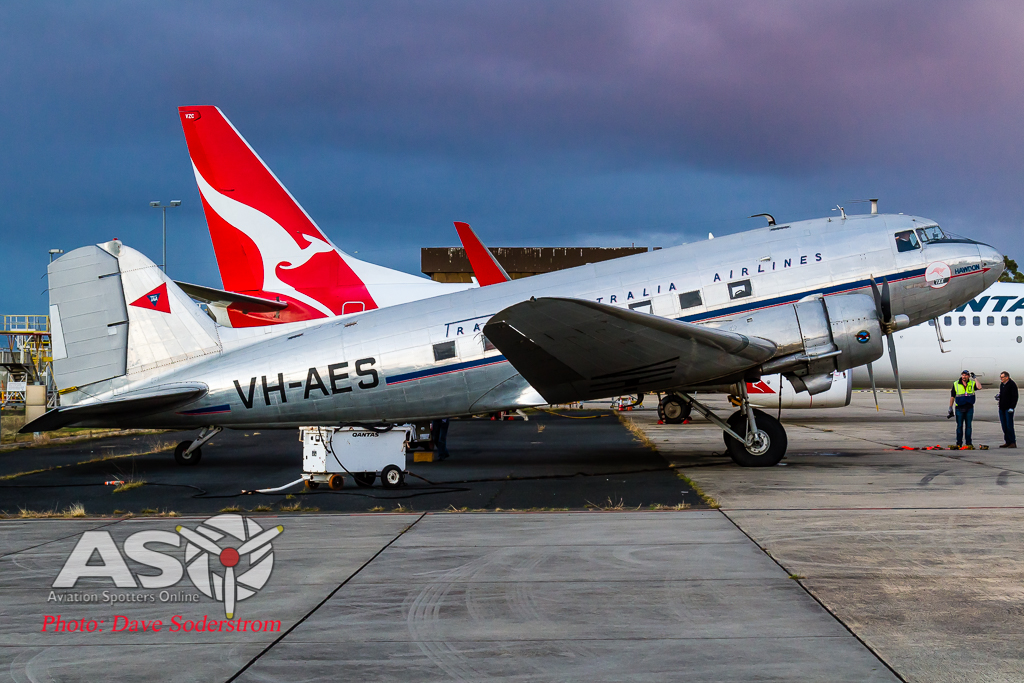
The engineers were already working away checking the aircraft over. Checking for water in the fuel system, checking oil levels, pins and chocks in preparation for engine start. 0730 arrives and our pilots for this great journey Alan Searle and Dave Wiltshire have brought Hawdon to life. The sound of two Pratt and Whitney R1830s humming away is pure music to an aviation tragic like myself. Its at this point I need to make a special mention of Alan and Dave, who were instrumental in getting Hawdon back into the air. It all started back in 1987 then Australian Airlines Captain Wiltshire happened to be at work and while looking out of his office window saw the sad looking VH-AES which had due to come down from the arch display it had been suspended in at Tullamarine Airport from 1979 till 1987. Dave meet with one of his senior pilots Alan and together the plan was formulated to save AES. An inspection of the airframe was conducted on the hardstanding to ascertain the condition of the aircraft, soon a committee was formed to return the aircraft to airworthy standards. To facilitate the two gentleman met with then Australian Airlines CEO James Strong with their vision.
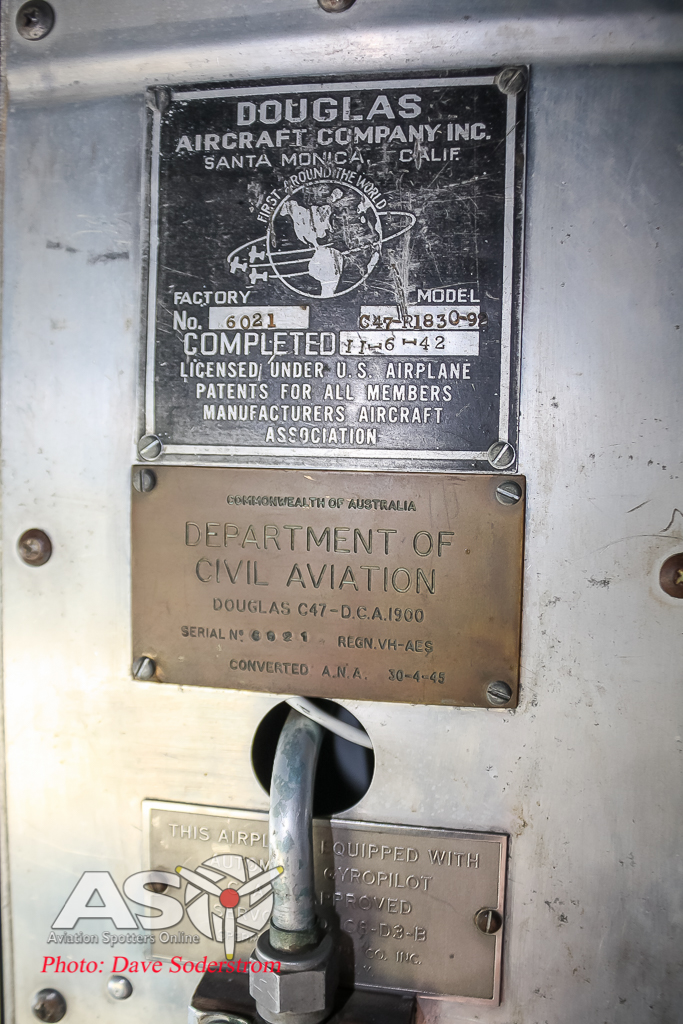
VH-AES conversion plate issued by the Department of Civil Aviation in 1945
Ultimately the decision to proceed was made and a separate operating entity was formed to operate under the name Hawdon Operations. The aircraft was stripped down to its bare basics and a full restoration was conducted. Many skilled tradesman from Australian Airlines were required for their various trades. From electrical, airframe, sheet and metal to paint and engine works all the various tradesmen volunteered their time before and after work to realise the project. In 1988 after a marathon effort Hawdon was rolled out in her hand polished finish just as she looked on the day of her first flight back in 1946. Since then the aircraft has appeared at many airshows including the Bicentennial Airshow, Mangalore, Coolangatta, Point Cook, Richmond and was even flown to Singapore in 1992 for the Asian Aerospace show. No small feet for a then over 50 year old aircraft. . Incidentally the aircraft has attended every single Avalon Airshow from 1992 to 2015.

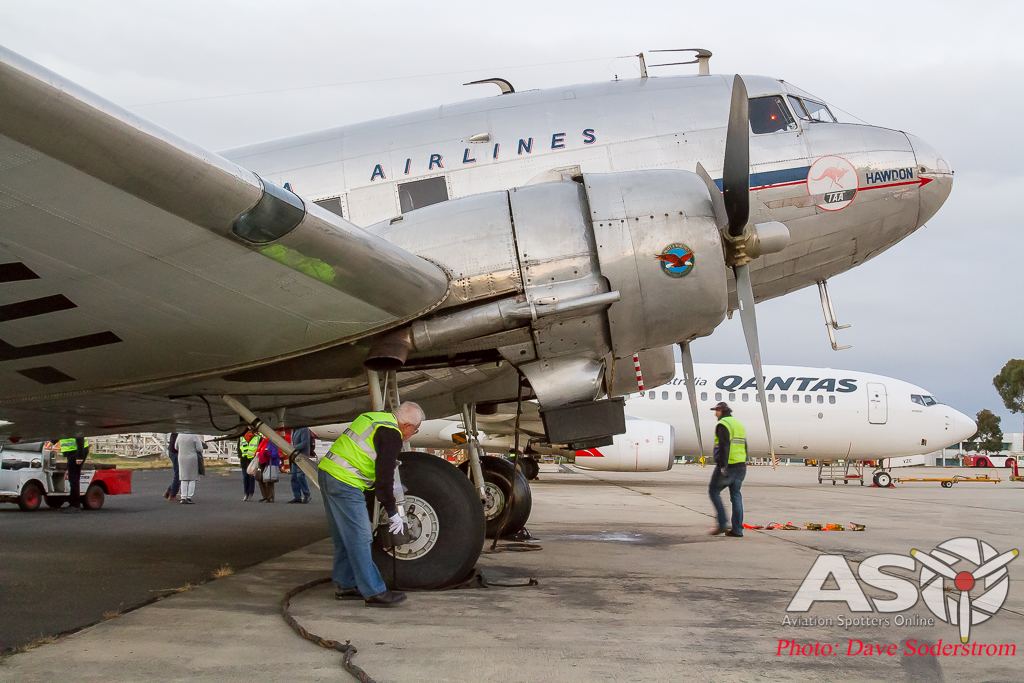
At 0745 Dave runs the engines up to take off power and begins doing a mag check. Temperatures are monitored, oil temps checked and rechecked. “Ok folks” is called from the flight deck. Noel one of the engineers gives us our safety briefing on exiting the aircraft in case of an emergency. Thumbs up to the cockpit, seat belt fastened we move out from the Jetbase one last time. Ted Dewey clears us to leave the parking bay I notice a somewhat sombre look on his face. I then click he is saying goodbye to ‘his baby’. I then look at the other engineers on board and I realise this is no ordinary trip this is one which has some real attachment to the people who have worked, maintained and flown the aircraft. Its a farewell from Melbourne from the TAA and Australian Airlines people who saved Hawdon and turned it into the icon it has become across Australia.

As I sit back in my seat right behind the bulkhead and look out over the 1830s at the many modern Boeing’s and Airbus’s across Tullamarine Airport I’m reminded where we have come from since the Douglas DC-3/C-47. Piston engines, to Turbo compound, early jets and the super efficient engines we see ploughing the skies today. A quick pause on Runway 34 to allow for the clearing of the runway from the Cathay Pacific A330 which had just arrived. Take off power is applied and the 1830s sing their glorious melody and with out much fuss or fanfare we depart Tullamarine climbing out over the airport a slight left turn and onwards to Temora in rural New South Wales.
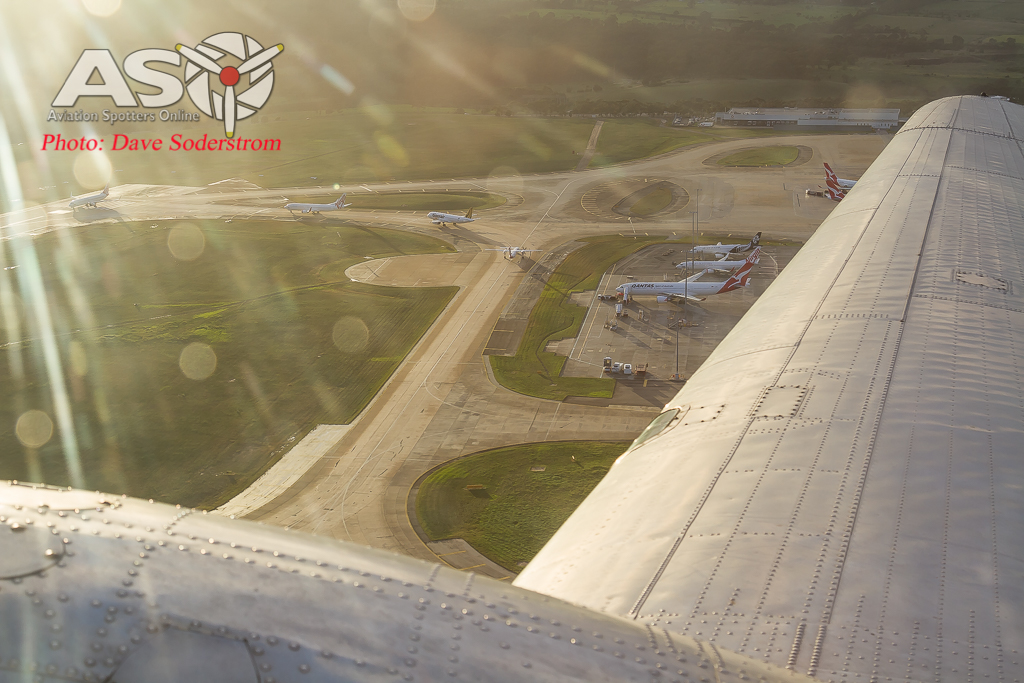
Departing Tullamarine with a stream of modern airliners below.
We arrived at Temora a little earlier than we expected, the high tailwind certainly helped a lot. Flying over rural Victoria and New South Wales after the high rainfall in recent weeks has made the countryside a beautiful sea of greens and browns. We line up for runway 23 at Temora which is the long of the three at the airstrip and Dave glides Hawdon and when we gently touch down the aircraft settles down so softly I’m taken back at the smoothness of the landing. We taxi up to the fuel bowser to replenish our tanks. A funny highlight was the need to push the aircraft back once refilled so it was all hands on deck to reposition the aircraft for departure. Chocks and pins secured and doors locked we wandered over to the Temora Aviation Museum as we had a two hour stop over.
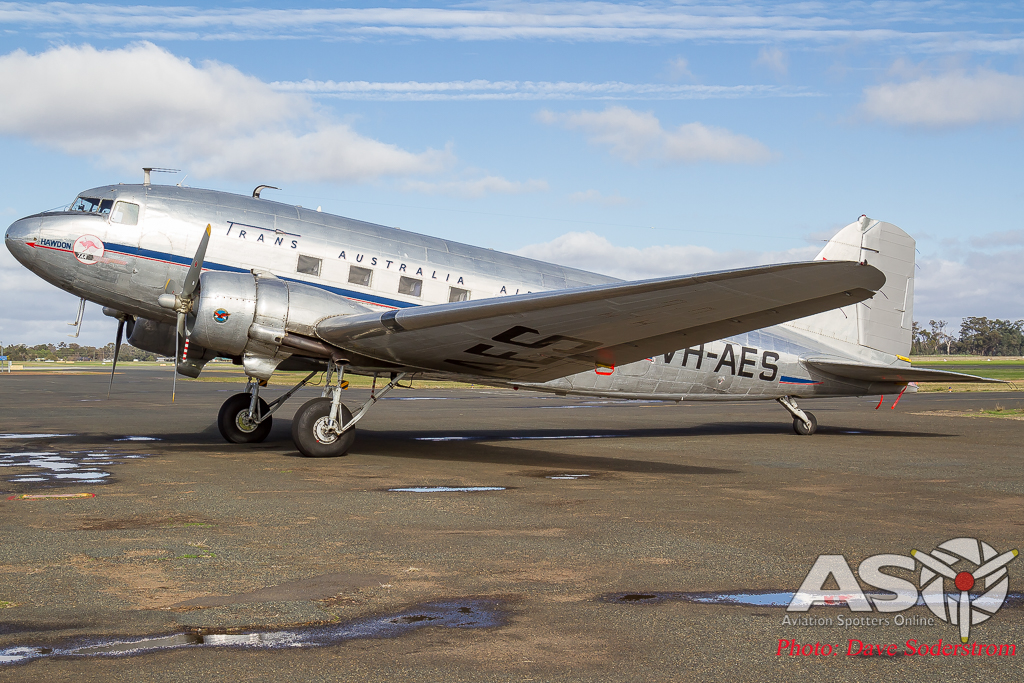
After a tour around the museum I headed out to watch some of the aerobatics aircraft who were at a aerobatic flight school based at Temora for the weekend.

Extra 300S VH-XTR was one of the aerobatic school attendees
Alan takes the Pilot’s seat for this sector of the flight to Albion Park, the 1830s roar into life and begin their usual harmony that radials do. We taxi out runway 23 again and Hawdon does what she does best…………..Fly! Agents right turn and we set course for Albion Park. Cruising along at 3700 feet I sit back and just take in the sounds, sights and the fact that I’m sitting in a living, breathing piece of history.
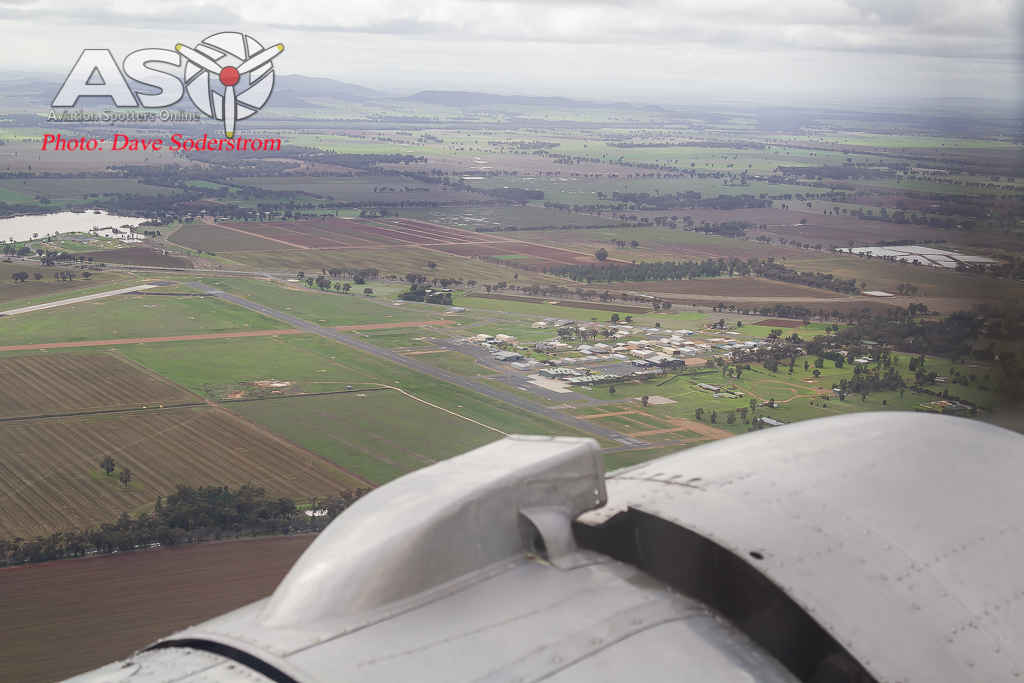
That thought process was interrupted when our hostie for the flight Alan’s wife served lunch. And while some reading this will think its a simple lunch consisting of a ham and mustard sandwich and a mandarin sometimes it’s the simple things in life that give you the most pleasure.
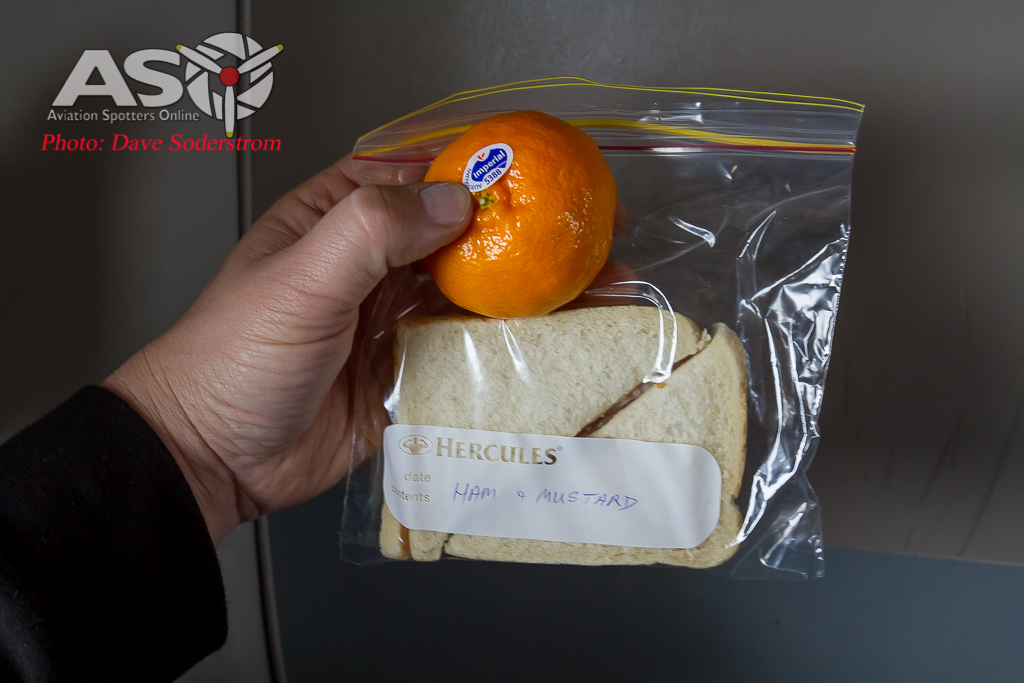
Its doesn’t feel long before we begin our descent into Albion Park. Just as I think the day can’t get any better one of the engineers tells me to get the camera ready as we are going to have a Mustang join us in the skies. Yep a genuine Commonwealth Aircraft Corporation (CAC) built Mustang would be flying along side us.
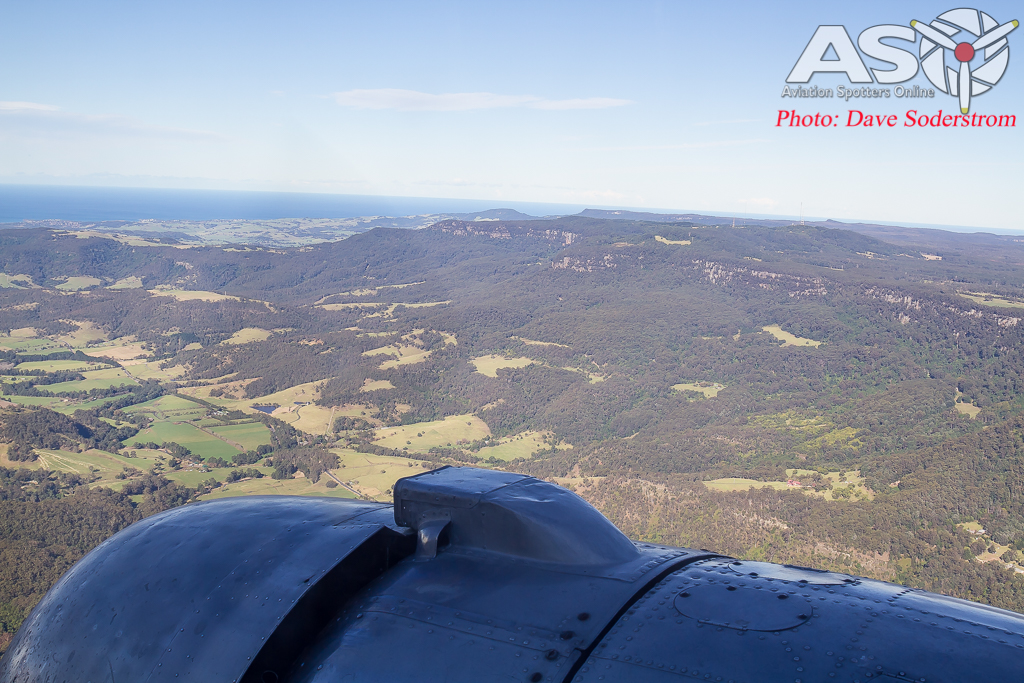
And no sooner had we passed the Illawarra escarpment and flying down the coastline that Mustang VH-MFT joined us. Could the day get any better? A wartime Dakota and a Mustang flying along side, I’d died and gone to plane heaven!
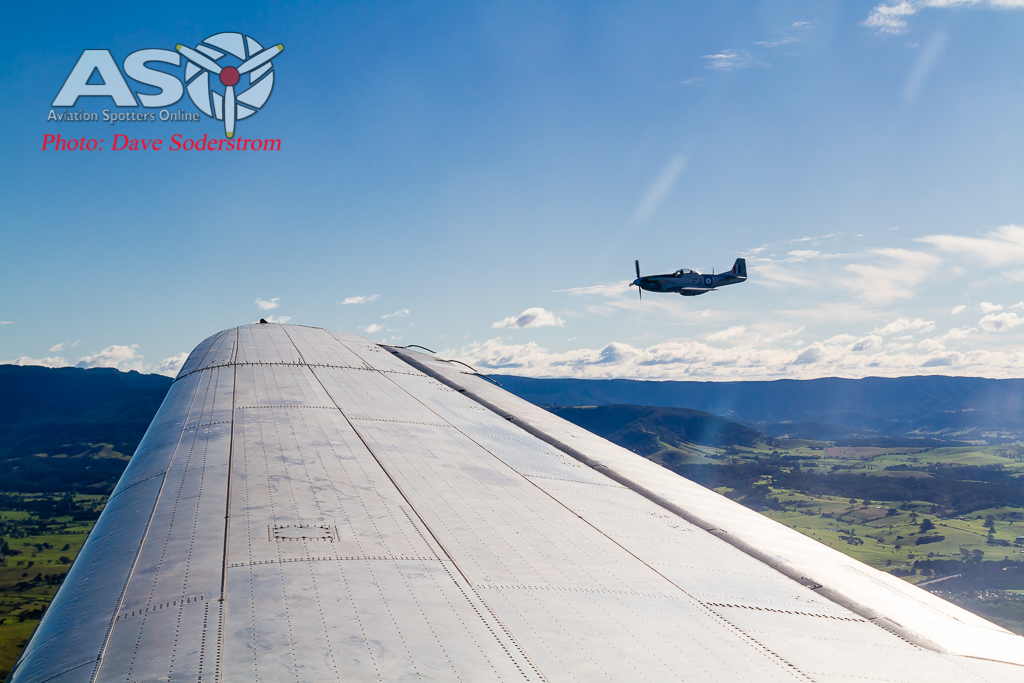
VH-MFT makes its first pass alongside Hawdon

The second Pass from VH-MFT, at this point Hawdon was moving around a lot due to the winds gusting off the ranges. We did one more pass up the coast and made a left turn to line up with runway 26. Gear down, lights are green, seat belts fastened and the ground approaching, Hawdon settles down onto the runway life a feather, softly and smoothly. Hawdon’s tail begins to slowly settle onto the ground, its something I enjoyed the feeling of the sloping backwards aircraft as it not something you experience on a modern passenger liner.
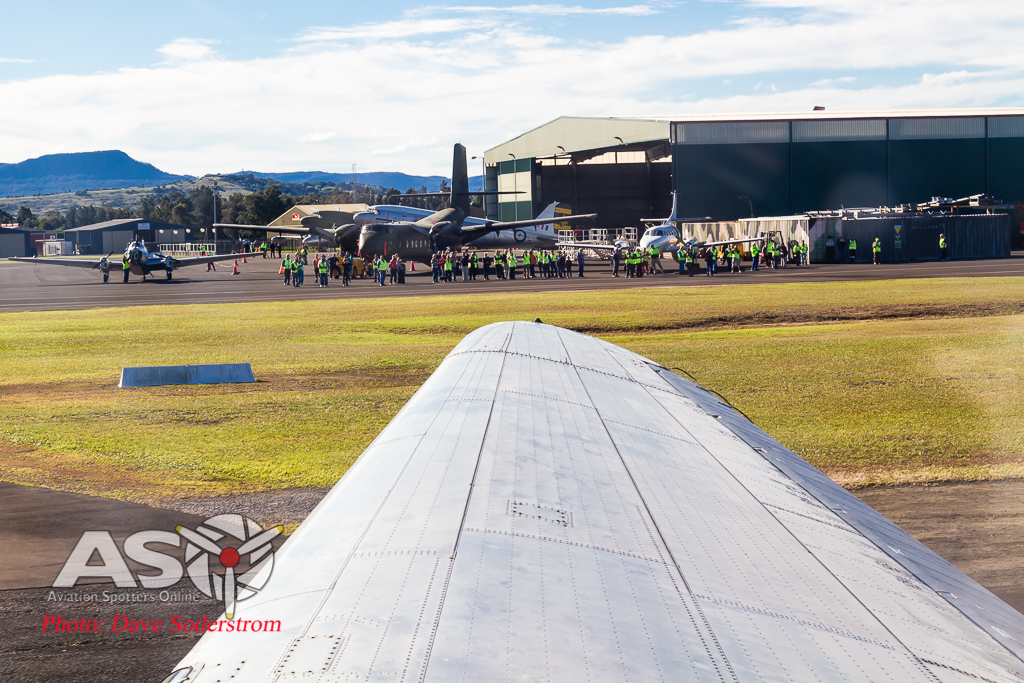
The welcoming company were out in force. Hawdon slowly taxied past the awaiting crowd I turned around to look at the other passengers, I could tell there was some sombre note to the engineers on the plane. This was it they were saying goodbye to their love, passion and pride today.

Dak from a Dak!
We taxi up to the waiting crowd and park alongside the two HARS ex Royal Australian Air Force C-47s VH-EAE and VH-EAF More on these later. Engines are shut down and the engineers race out to look over Hawdon one last time. The smiles beam as their old stead has done what she has done from its earliest days, getting its cargo to where it needed to safely and securely. Jason, Noel and Mark exit the aircraft to locate the pins, chocks pitot covers and cleats are all secured one last time.
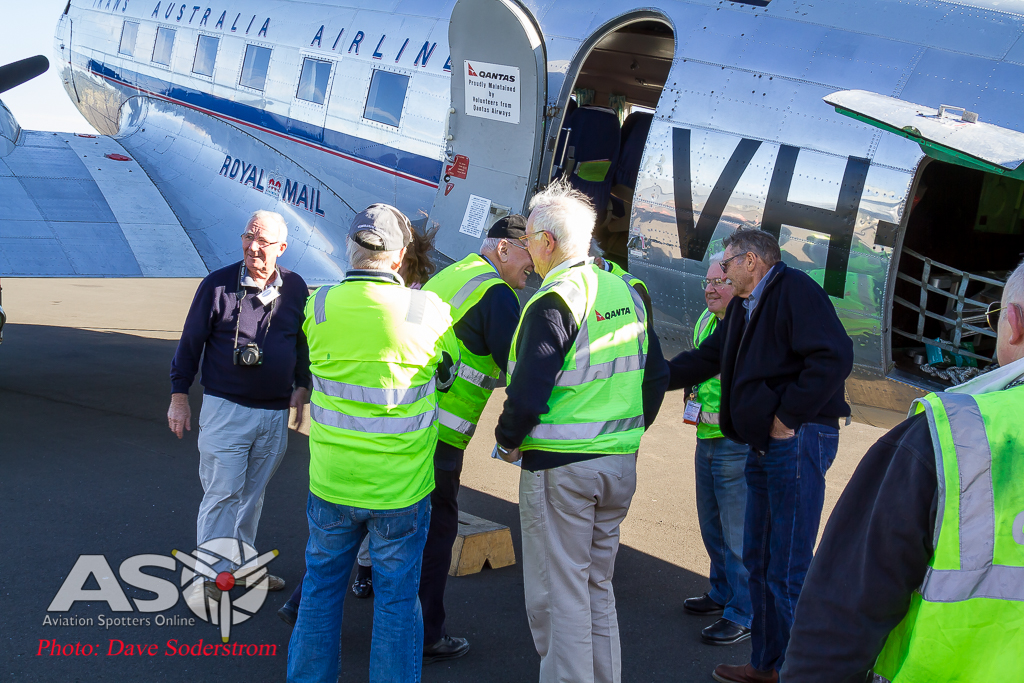


(Left to Right) Jason Burgess (Hawdon), Bob De Le Hunty (HARS), Dave Wiltshire (Hawdon), Alan Searle (Hawdon) and Mark Dewy (Hawdon) with Hawdon.
We are greeted by the large number of HARS volunteers. President of the organisation and chief Pilot, Bob De Le Hunty, Don Hindle are some other great people we get to meet and shake hands with after arrival.
We are treated with absolute professionalism by everyone at HARS and so is Hawdon, everyone realises the significance of the day, the flight and the hour it will be being the caretakers of this very lovely old lady. The tug is hooked up to the tail wheel and we position the aircraft to line up with its other Douglas brethren.

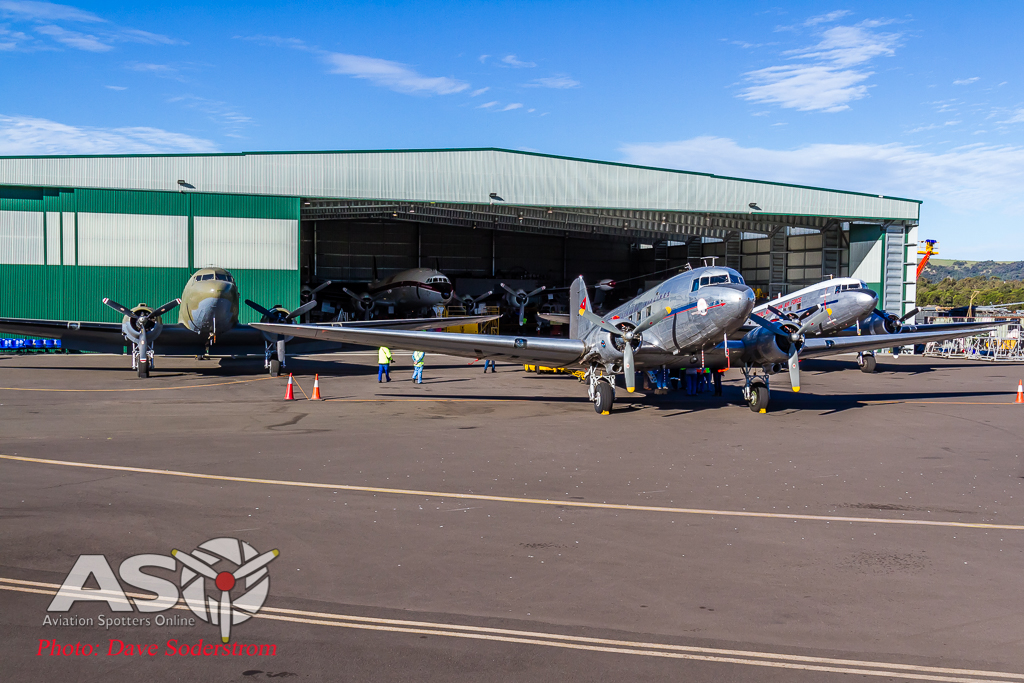
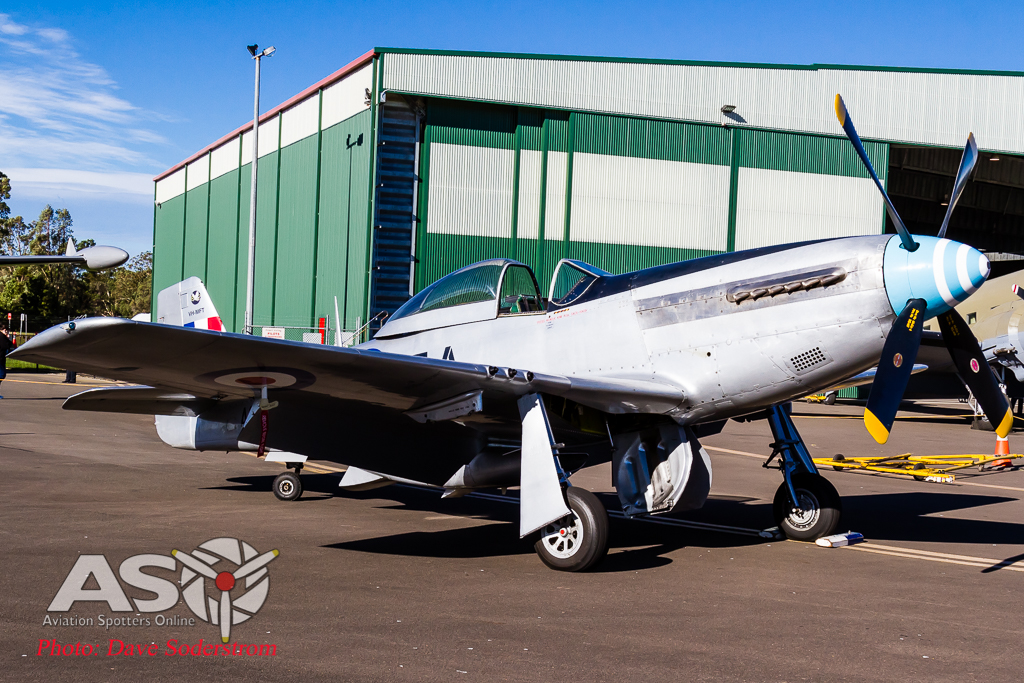
VH-MFT CAC Built Mustang A68-110 marked as A68-769 ‘Snifter’
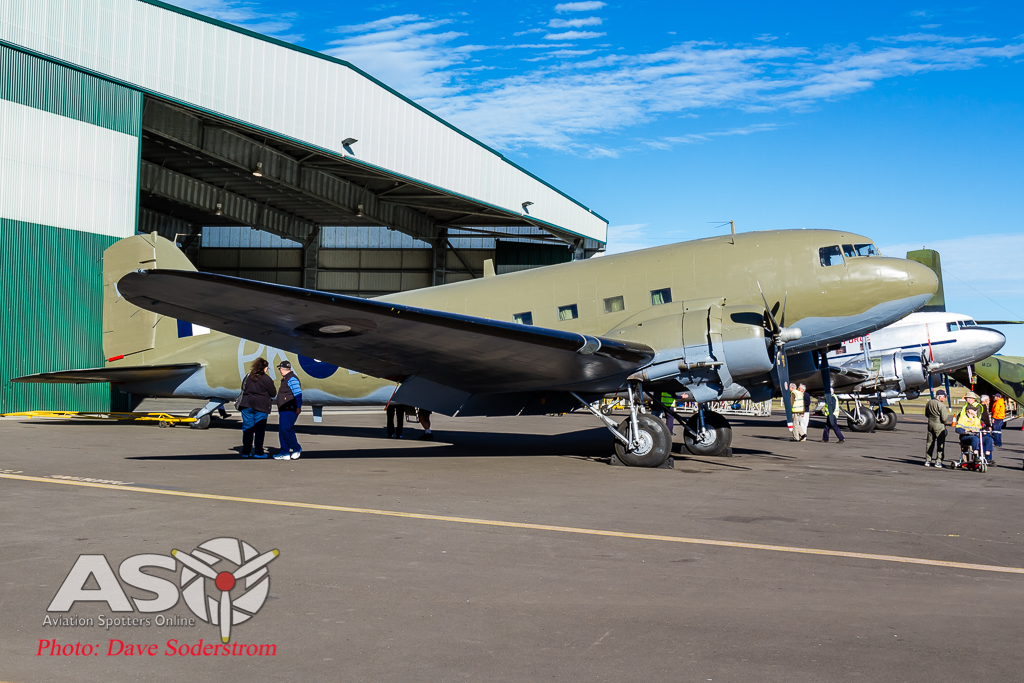
VH-EAE ex RAAF A65-95 C-47B.
One of two ex military spec Dakotas in the HARS fleet VH-EAE, was delivered to the RAAF in 1945 and would see service with the RAAF flown in New Guinea and the South West Pacific theatre during World War Two. Its last assignment was with the Aircraft Research and Development Unit (ARDU) based at Edinbrough in South Australia. Now marked in Wartime markings as used in the Pacific again it stands as a fine tribute to the Dakota in Wartime service.

VH-EAF ex RAAF A65-94 C-47B
VH-EAF, was also delivered to the RAAF in 1945. Following wartime service and in a later war A65-94 was part of C flight, 2SQN based at RAAF Butterworth, opposite Penang Island, Malaysia. She flew the first operational mission of the Vietnam War, delivering food and medical supplies to refugees fleeing the fighting. Later years saw use as a VIP Transport In its twilight years it was tasked to the Aircraft Research and Development Unit (ARDU) alongside A65-95 until its retirement in 2000.


As the sun started to set on for me was an absolute honour and privilege to be apart of this occasion, I want to personally thank the great people who I was introduced to at HARS the crew from Hawdon Operations for allowing me to share their story. All of you were extremely hospitable and were all willing to share your knowledge and stories with me. Thank You. Finally thanks to Jason, mate I hope this does you and the crew proud.
Video on the flight from onboard.
Technical Specifications for the Douglas DC-3/C-47 family.
Engines: 2 x Pratt & Whitney R1830-92 (~30 L), 14 cylinder, 2 row, air-cooled, supercharged, radial, ~1,200 bhp each
Maximum takeoff weight: 12,700 kg (payload ~3,400 kg)
Carrying capacity: 28 paratroopers (military), 20 passengers (commercial)
Length: 19.63 m
Wing span: 28.96 m
Height: 5.16 m
Cruising speed: ~270 km/h (max ~350 km/h)
Ceiling: 23,200 ft
Range: ~2,400 km
Crew: 2 x pilots, 1 x navigator (depending on operator)

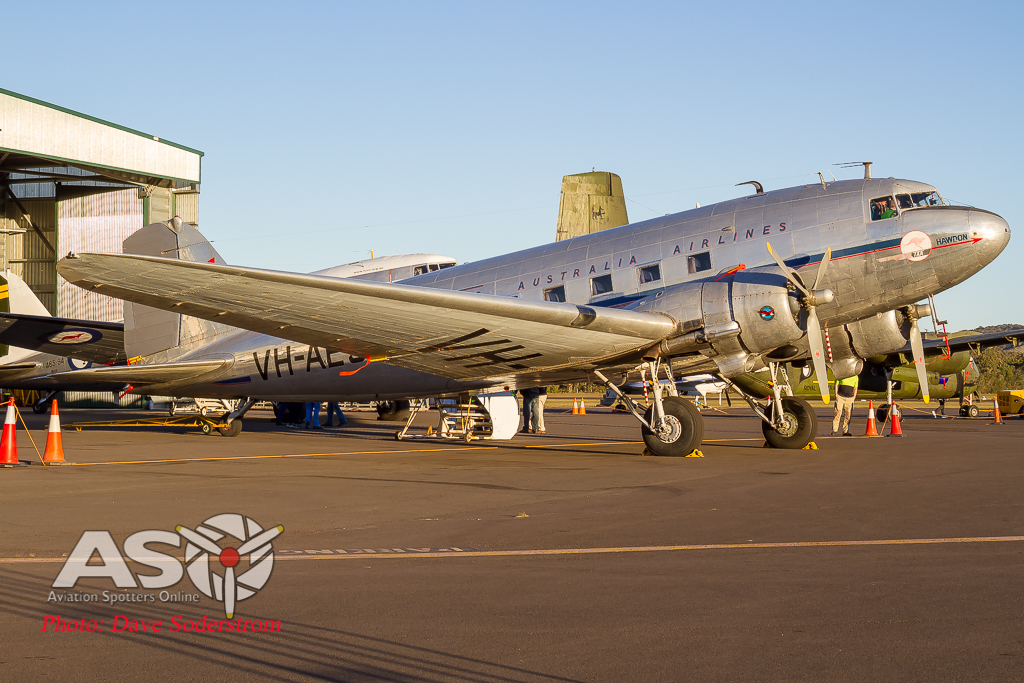

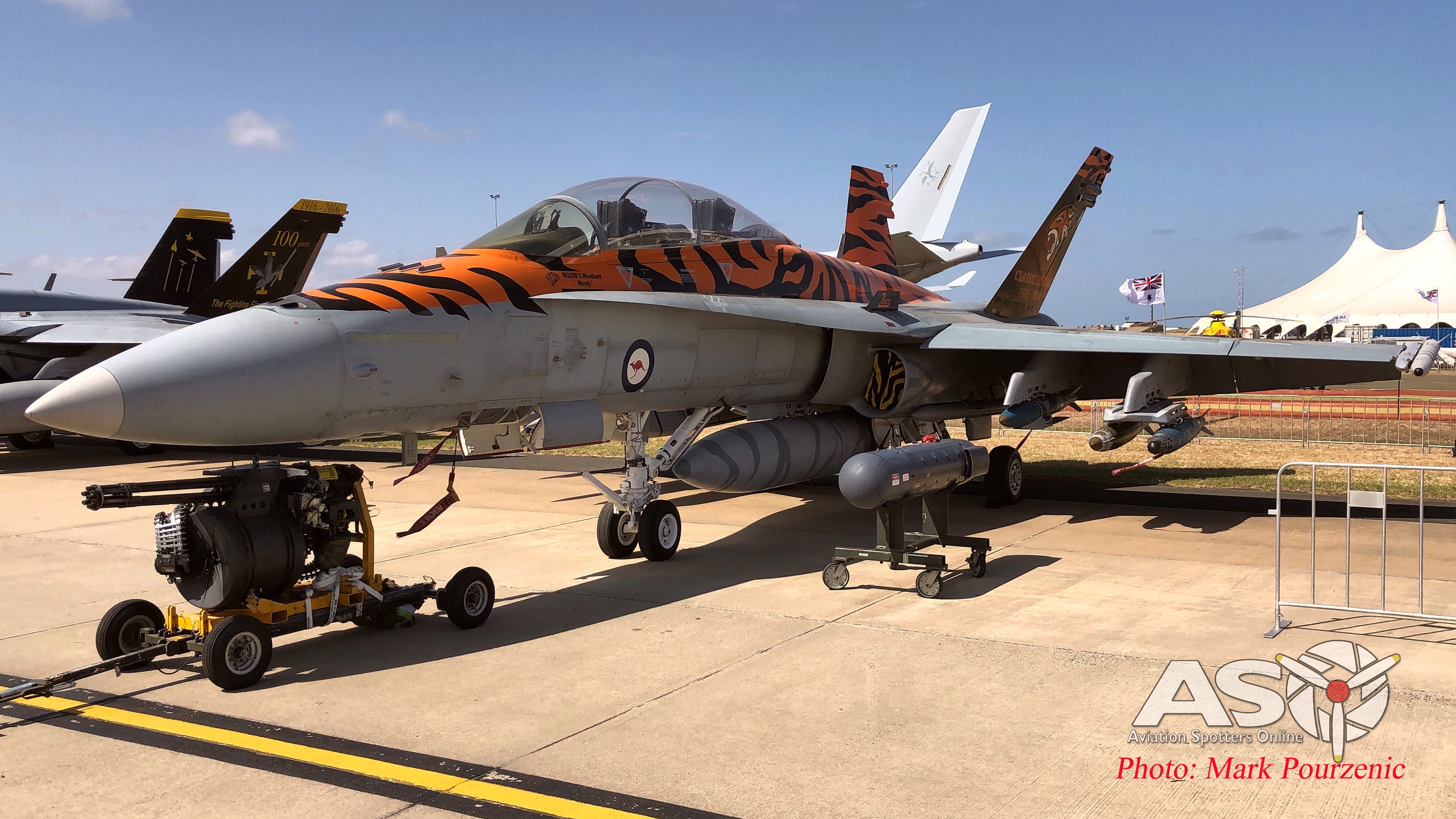
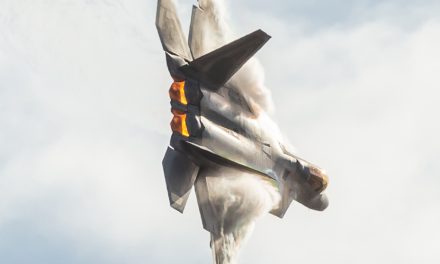
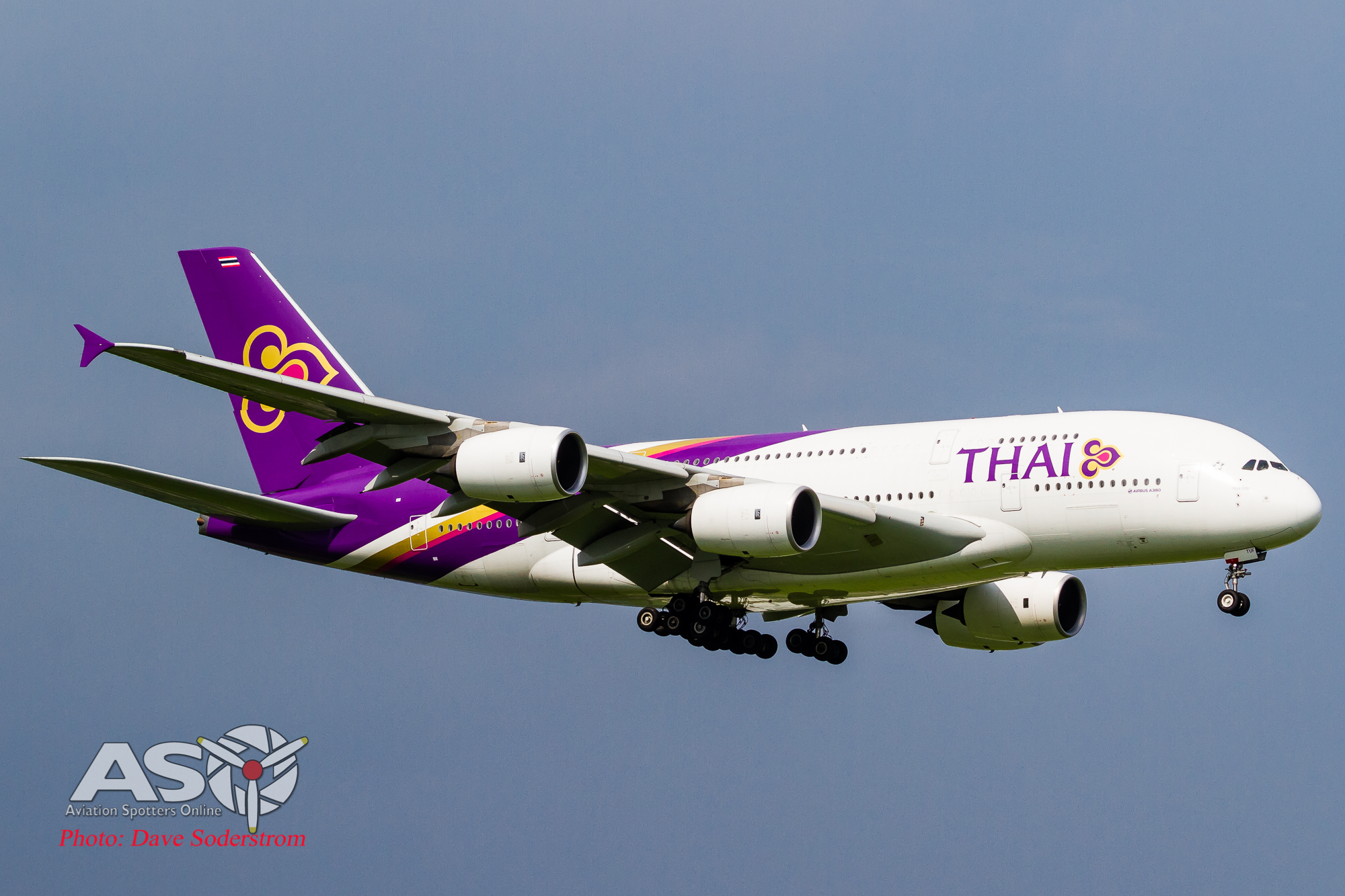





Great coverage, Dave but please correct the name of TAA. It was Tarns-Australia Airlines. (With hyphen until 1980). i.e. NOT Trans Australian Airlines. Look at the sign-writing on third photo.
(Change of name to Australian Airlines occurred on 4 August 1986.)
Thank you,
Warwick Henry (employee of TAA for approx 20 years until the change of name to Australian Airlines on 4 August 1986
Hi Warwick, noted and amended thanks for the pick up, cheers Dave.
Thank you Warwick for the correction which we will fix now . -Mark.
Re W Henry’s comment regarding the name of TAA – It was not TARNS- Australia Airlines as he suggested
Don’t forget the “girls” who regularly assisted with AES’s restoration. Sue, Nancy and Nan to mention a few.
A great report, thanks Dave. My involvement with AES has been from a slightly different perspective. I drove the tug to tow it from the Tullamarine Tarmac under the roadway into the car park in 1979. I sat my 3 yr old son on the tail the next day before the lifting into the support. 7 years later outside the hangar, again I put him on the tail. He told me then that ‘its smaller Dad’. He now flies C-17’s. He was inspired by that experience and she is still here to do it over again. Well done all.
An interesting report on early beginnings.
Recently attended school reunion,Nowra High School.Visitd HARS museum at Albion Park en route to Nowra.Having served in PNG (TAA) 1969 -1974) it certainlybrought back memories. Many photos were taken whilst there.The DC3 featured, is now a
canvas reproduced from one if these photos.
could you confirm your seating stats. I was regular passger Melbourne Hobart during part of the exciting period of piston aviation and I thought the DC3 pax was 28 where you put 20 and 28 paratroopers?
thanks.
Hi Gerald, the figure is a generic one. All operators of the type had varying configurations.
Where could I get a really good picture of the Hawdon. Our family name is Hawdon and I think my father would really enjoy one.
Hi Melody, If you’d like a couple of images I have several so let me know and I can help you. Cheers Dave
D ear Dave and fabulous team @ Aviation Spotters online.
I missed this report when it was released and sincerely thank you for it’s content. I grew up on C47’s at MMA in the West where I did my apprenticeship on these magnificent Gooney birds before migrating to PNG to continue my love affair on the Qantas fleet. The nostalgia continues every time that I see or hear a Pratt & Whitney R1830 on start up. Wheeze, wheeze cough smoke and fire up; there’s nothing like it. Keep up the good reports, they keep me young! Many thanks once again.
Hello everyone, read the comments with great interest. I am 76 and my association with the DC3 goes back to 1945 & even before then. Dad worked for Commonwealth Dept of Customs & Excise and being a Govt Employee we were required to fly with TAA, a C’wealth Government Airline and we flew from Cairns, Qld to Darwin, NT in early 1945. I started work in Dec 1960 with the C’walth Bank and served in PNG twice. Being owned by the C’wealth Government we were required to fly with TAA. It was and is known as TRANS AUSTRALIAN AIRLINES. It was never known as TARNS AUSTRALIAN AIRLINES. Following C’wealth Govt directions via an enactment of Parliament TAA was taken over by QANTAS to form a single non competitive airline. Its competition was ANA – Australian National Airlines. Later came Ansett Airlines that did in time acquire ANA. Eventually Ansett airlines was taken over Air NZ. Qantas is still flying honourably for Aust.
I am blessed to be able to say I crewed her as an offical flight attendant single operator in April 1994 for Australian Airlines Good Friday charity bay flights. Proceeds went to the Royal Melbourne Children’s Hospital. Have pics. Hope the bright orange feather duster is still onboard.
Great story, thank you. Am I correct in assuming the HAWDON and another aircraft the JOSEPH HAWDON are both named after the Hawdon pioneering family, in particular, Joseph Hawdon, Australias First Overlander.